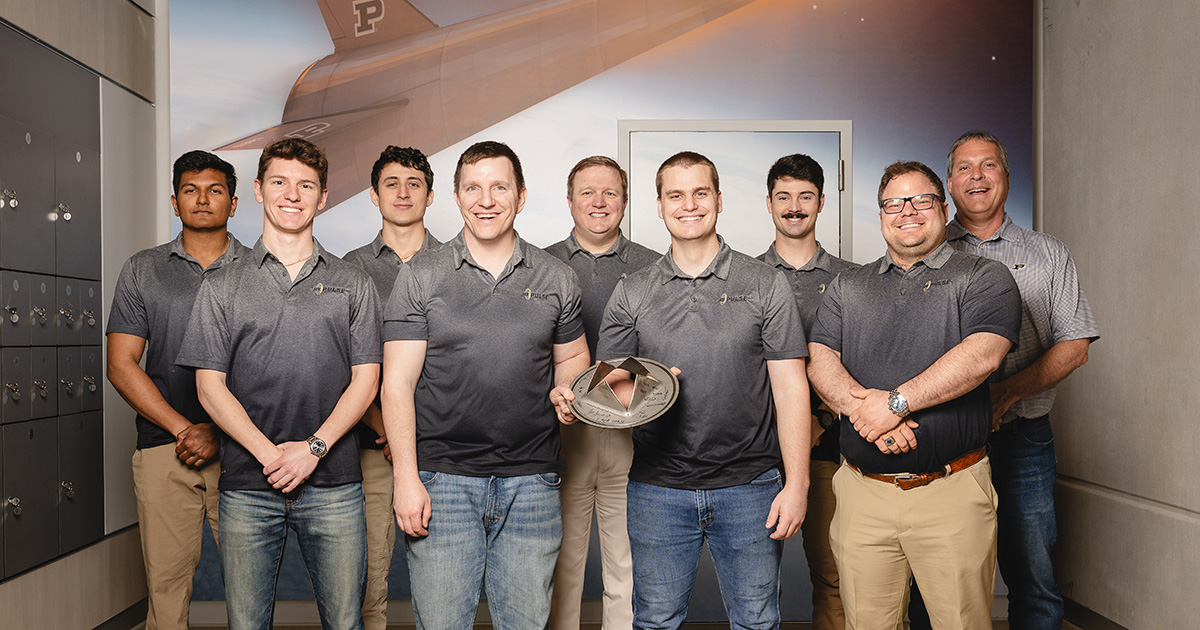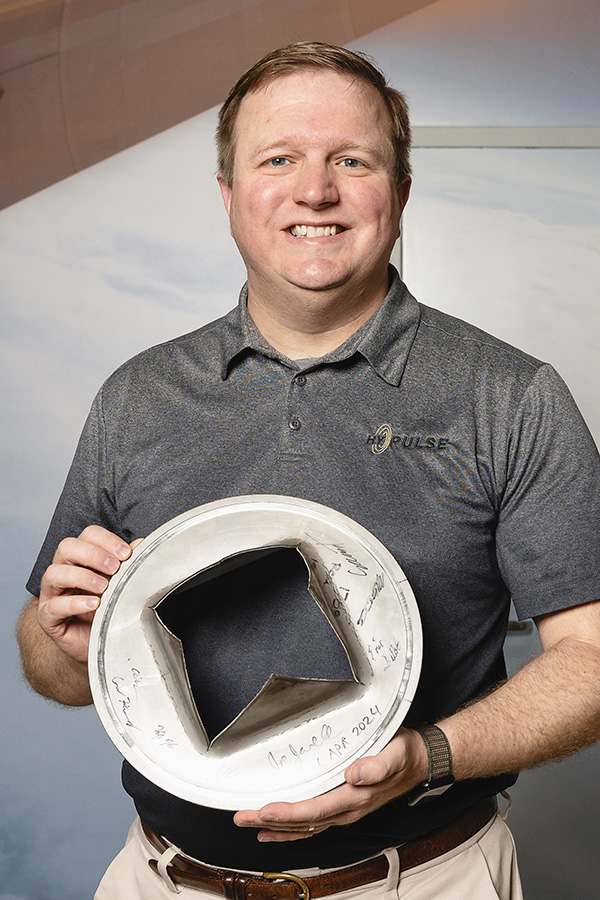Purdue successfully tests HYPULSE shock tunnel capable of replicating Mach 40 conditions
| Author: | Alan Cesar |
|---|

It’s nearing 3 p.m. on April 1, 2024, and six graduate students, a research assistant and an associate professor have been watching pressure graphs closely for most of the afternoon. Since the previous summer they’ve been working to fire up a new test tunnel in Purdue’s super-secure Hypersonics and Applied Research Facility (HARF), dealing with impossibly tight tolerances even for a so-called “low-pressure” test.
The qualifiers for this are baffling: Building up the driver reservoir to “just” 1,900 psi, a far cry from its 20,000 psi maximum. A high-speed camera slowed down to “only” 20,000 frames per second, so it can be run continuously. They’re expecting “merely” Mach 7 flow, just a start on the way to its Mach 40 limit.
Even when operating so far from maximum, the 6-inch-diameter steel shock tube must be perfectly straight — deflecting no more than an eighth of an inch every 30 feet.
As the first test, they don’t expect everything to go perfectly. But it does, nearly. In the final minutes pre-test, they must program a workaround to the filling routine to compensate for a minor leak. Everything else is going exactly to plan.
The team — consisting of grad students Kyle York, Jared Slack, Adrian Flores, Connor Hennessy, Samant Mahipathi, and Grant Dilley, and senior research engineer David Tibbo — double-check everything on their 9-page startup procedure.
It's time. They pass around ear plugs. Hennessy hovers the mouse cursor over the “go” button.
He clicks.
A deep hissing emanates through the brick wall. There's a subtle pop, and then a few seconds of a whistling sound. A black-and-white output display from the high-speed camera shows something that resembles the driving rain during a hurricane.
Smiles explode across the faces of everyone in the room.
Associate professor and HYPULSE director Joe Jewell and Zucrow Labs managing director Scott Meyer share a high five, and cheer for the team: “Great job, gentlemen!”
"HYPULSE is versatile because you can put in any gas you want. We can mix up the atmosphere of Titan, or one of the outer planets, or fill it with CO2 to match Mars."
They all clap for one another. They clap for themselves. Running back the high-speed video, they click through the frames one by one, watching the flow transition from dirty air to the steady-state test blast. They see what they’ve been hoping for: A distinct shock wave bending downstream of a metal bar in the test section, that they later calculate at Mach 7.
As eager PhDs, the students begin looking for ways to analyze what they see. Jewell tempers their enthusiasm. His own PhD work more than a decade prior, using the T5 Reflected Shock Tunnel at Caltech, gives him perspective. “Be happy you got a Schlieren,” he says, referring to the special optical method used to photograph pressure shockwaves and density gradients — “but don’t claim it was science!”
Reviewing the display screen from an oscilloscope, they also see that each of the three pressure transducers indicated a pressure spike. They cheer again. Not only have they shown that it works, but they’ll also be able to calculate the shock speed and flow conditions from that data, and fine-tune the camera triggering to run it at higher framerates. Now they can submit research proposals.
It’s pure excitement. Until —

“Oh no!” one student says. “It didn’t save the data.”
The room falls silent. Their mouths hang open as they imagine their months of work nearly vanishing. Or picturing what went wrong. Or wondering how long it will be until they can test again.
“April fools?” he says, sheepishly. The room laughs in relief. “Too soon, man!”
A milestone for testing hypersonic missiles and atmospheric entry vehicles
Jokes aside, the first test of Purdue’s HYPULSE reflected shock/expansion tunnel was an unqualified success. This test, four years in the making, was just a starting point. They verified the pumps, valves, seals, sensors and data collection systems, and identified weaknesses to address on their way to testing at higher levels of pressure and enthalpy.

This system’s original design, shown in yellowed drawings signed by NASA draftsmen in the HYPULSE office, dates back to the 1960s. It was upgraded many times in the decades following as it continued to change hands, finally being donated to Purdue in 2020 by Northrop Grumman.
Jewell’s experience — which includes running the Boeing/AFOSR Mach 6 Quiet Tunnel, a shock tube, and other aerodynamic research equipment at Purdue — informed the construction plans for the HARF building that would house HYPULSE. He led adding upgrades and refinements as the system was installed, making it capable of taking millions of data points per second with modern instrumentation techniques.
That extreme headroom makes it suitable for far more than cutting-edge hypersonic missile systems — its flexibility makes it capable of testing spacecraft that would enter atmospheres other than Earth, or on very high Mach number trajectories returning astronauts from the moon or Mars.
“HYPULSE is versatile because you can put in any gas you want. We can mix up the atmosphere of Titan, or one of the outer planets, or fill it with CO2 to match Mars,” Jewell says.
“This opens up a lot of potential for Purdue. Very few universities have anything like this. We have a huge amount of interest in it,” he adds. “HYPULSE opens up entirely new pathways for hypersonic research.”
After the cheers died down and Jewell had congratulated each of his students, he took a moment to reflect on his progress. Appropriate to the theme of the day, he expressed disappointment — but firmly tongue-in-cheek.
“I’ve been saying for years that we would have this running by the first quarter of 2024,” he says. “Getting it running on April 1, well, it made me a liar by one day.”
